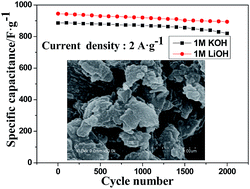Layered manganese-based metal–organic framework as a high capacity electrode material for supercapacitors†
Abstract
For the development of supercapacitors with higher energy densities, metal–organic frameworks (MOFs), as electrode materials for supercapacitors, have attracted much attention. Herein, layered manganese-based MOF ([Mn(tfbdc)(4,4′-bpy)(H2O)2], Mn-LMOF; H2tfbdc = 2,3,5,6-tetrafluoroterephthalic acid, 4,4′-bpy = 4,4′-bipyridine) was synthesized by a simple solution reaction and evaluated as an electrode material for supercapacitors for the first time. The Mn-LMOF electrode showed a high specific capacitance, a good cycling stability and a improved rate capability. Its maximum specific capacitances were 1098 F g−1 for 1 M KOH and 1178 F g−1 for 1 M LiOH solutions at a current density of 1 A g−1. The specific capacitance retention was maintained at 92.6% after 2000 cycles in 1 M KOH, slightly lower than that in 1 M LiOH. The excellent supercapacitive performance may be ascribed to the nature of Mn-LMOF, containing a layered structure and nano-sized particles.

- This article is part of the themed collection: 2017 Review articles


 Please wait while we load your content...
Please wait while we load your content...